
Darjeeling

As you look up Darjeeling tour packages, it makes sense to have a fair idea about the destination you are planning to visit. Darjeeling is like a gorgeous ribbon wound around a tall and jagged mountain ridge and surrounded on all sides by lush tea plantations.
The scenery is completed by the towering white peaks of the majestic Khangchendzonga. Darjeeling, a hill station in West Bengal is popular for its undulating tea estates, views of the Himalayas and its verdant greenery. At Darjeeling you will be rewarded with uninterrupted views of the Khangchendzonga which is the third largest mountain in the world.
You would be occupied through the day visiting Buddhist monasteries, elegant colonial-era architecture and not to mention, have fun riding on the 140-year-old Darjeeling Himalayan Railway, billowing wispy smoke into the blue sky. Those in love with the outdoors can hike up to the Singalila Ridge. There would be ample opportunities to go mountain biking on the hill slopes.
When not exploring your scenic surroundings, walk up the steep, winding bazaars that are choc-a-bloc with knickknacks, souvenirs among other items locally produced and sold by people from Tibet, Sikkim, Nepal and Bhutan. A Darjeeling trip is incomplete if you do not unwind at a local tea stall and enjoy a strong brew to go with a plate of steaming momo
Places to Visit
While shortlisting one of the Darjeeling holiday packages, ensure it includes the rarer gems, the local haunts and the traditional touristy spots. On a holiday in this very cosmopolitan hill station, you will be spoilt for choice for there are so many sights that you would feel if only you had more days on your hands.

Darjeeling Himalayan Railway
Popularly referred to as the toy train, the Darjeeling Himalayan Railway as an extension of the North Bengal State Railway went on its first ride in 1881 on two-foot-wide tracks, climbing the arduous 88 kilometre to Darjeeling from New Jalpaiguri through Siliguri.
It is still among the few operational hill railways in the country and also a UNESCO World Heritage Site. It is a thrilling ride of two hours from Darjeeling to Ghum and back cutting through pristine mountain scenery, taking in the fresh air, under a clear blue sky. On a visit to Darjeeling you can spot the toy train following the Hill Cart Road, crossing it periodically.
While the toy train has lost its importance as a mode of transport the way it used to be in the British era, it still has vanity value, bringing in hordes of tourists to the hill station to experience this joy ride. There are about six of them that are pulled by steam locomotives, an antique in itself and about three or more that function on diesel-operated engines.
One diesel-powered train traverses the route everyday from New Jalpaiguri to Darjeeling, taking 7 hours in each direction to cover the 88 kilometres. The other goes from Kurseong to Darjeeling and returns to the starting point. The first-class coaches have large windows, affording magnificent views of the hills and the forests and an entire wild terrain opens up before you as the scenery slowly unfolds.
Second class too gives you a great view but is often crowded. The railway reaches its highest point close to Ghum at Jorebungalow at 7998 foot just 7 kilometre shy of Darjeeling and suddenly you are faced with the panorama of the Khangchendzonga range. Beyond Ghum the train makes a circle at the Batasia Loop, the most dramatic of the three loops the train makes.
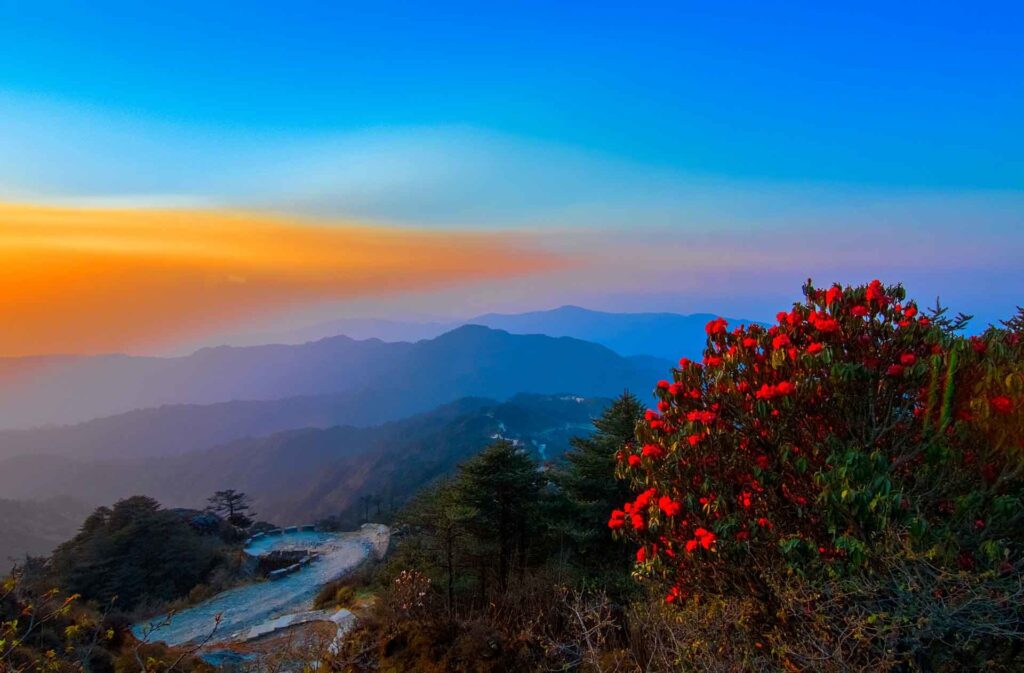
Singalila National Park
One of Darjeeling’s finest trekking zones, the Singalila National Park pans across the Singalila Ridge on the India-Nepal border to the west of Darjeeling. It opens up a grand sweeping panorama of the eastern Himalayas and takes you through unspoilt patches of rhododendron wilderness, a riot of reds and purples when in flower in late April and May.
The popular entry gate to the park is near Tumling, about 25 kilometre from Darjeeling to Sandakphu. You would have to take a local guide to access the park. You might have to carry your passport to register at the Frontier Check Post and in other places too. You can hire a jeep to access the park from the Singalila Land Rover Owner’s Welfare Association in Mane Bhanjang.
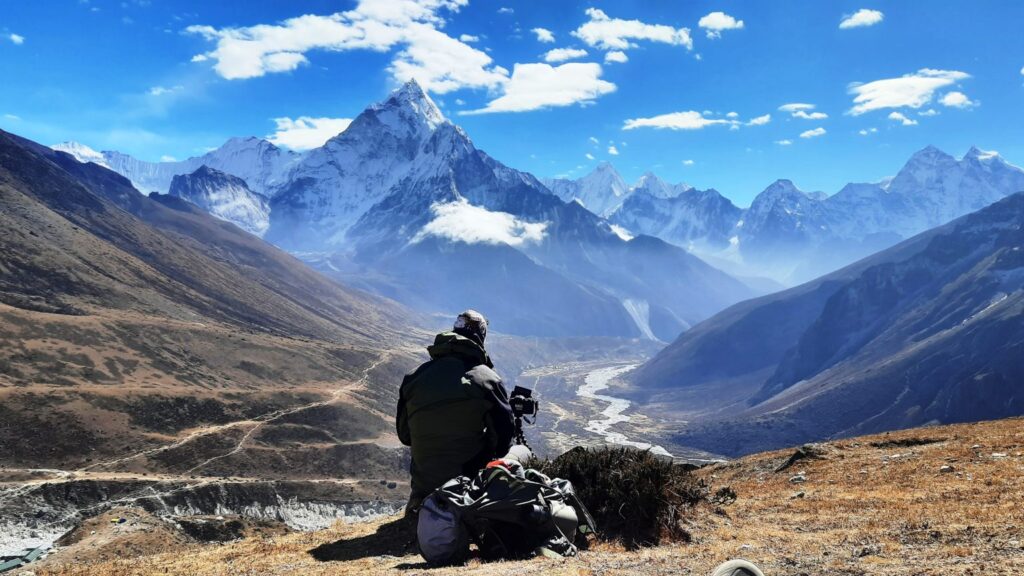
The Singalila trek: Mane Bhanjang – Phalut trail
The Singalila Range rises close to Darjeeling and goes all the way to the peak of Khangchendzonga. There are some really long trails that have been etched out in Sikkim, though there are no provision to connect them to the lower reaches of the ridge to Sandakphu and Phalut in Darjeeling district.
The Maney Bhanjang – Phalut trail affords magnificent vistas of the upper reaches of the Khangchendzonga. Treks and hikes are possible in this terrain as there are a few lodges and huts as well as food stalls along the way. For an overnight expedition, you are required to carry your sleeping bag and woollens as the weather is usually cold.
Maney Bhanjang is a little town about 27 kilometre from Darjeeling. It serves as the starting point of your trek, opening up breathtaking views along the Sandakphu-Phalut region of the trek. You would be required to pay an entry fee to the Forestry Department in order to enter the park. It is mandatory to hire the services of a guide, available via the Highlander Guides and Porters Welfare Association.
Head to Chowk Bazaar in Darjeeling early morning and take a shared jeep to Maney Bhanjang. If you are a serious trekker visit after the monsoon rains ebb between October and November or in the spring season between February and May. While it could be quite hot by the end of April and beginning of May, but you wouldn’t really mind the heat as the rhododendron jungles are in flower in this season.
You can even plan a trek to Jorethang on the Sikkim border.
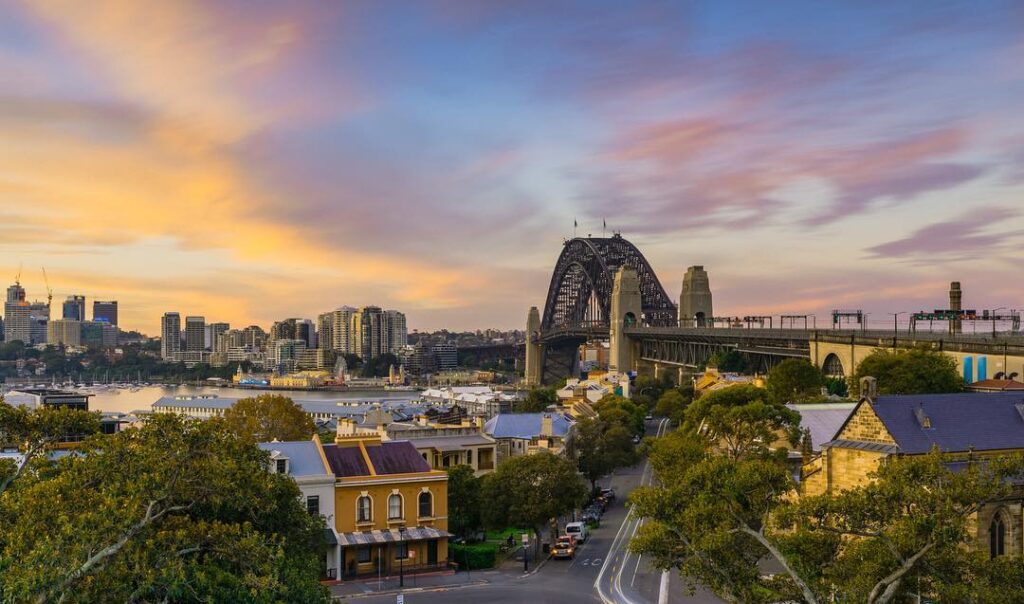
Observatory Hill
Over the Chowrasta rises the Observatory Hill that houses many popular temples in the region. The approach to the temple is beautiful and laden with colourful prayer flags and bells. The main shrine belonging to Mahakala is on the summit of the temple. Mahakala is a Buddhist deity who is worshipped as a fierce avatar of Lord Shiva.
The temple has a Hindu priest and Buddhist lama in a brilliant display of religious tolerance and coexistence. About 328 foot on the eastern Mall road from Chowrasta begins the ascend to the summit through a path that goes up 984 foot. You will find a host of other temples on the hilltop that includes a narrow cave with a Shivlingam.
The summit may not have any panoramic views but if you go back down to the Mall and turn north, you will be able to find viewpoints with views of the Khangchendzonga ranges. The Observatory Hill is of historical significance too, for it was the erstwhile location of the Bhutia Busty Gompa, the monks having given Darjeeling its name, derived from dorje-ling or place of thunder.

Kalimpong
About 50 kilometre east of Darjeeling is the serene hill station of Kalimpong that might seem a bit rundown in the beginning but is not without its charms, which you would discover on your little jaunt. At the heart of Kalimpong is a lively market, a riot of colours, giving the hill station its bazaar-town status.
Other than that as you explore around in Kalimpong you will come across an overwhelming profusion of orchids and a range of other rare and exotic flowers, a string of monasteries, endless hike and trekking trails in the surrounding hills that are home to the original inhabitants of the area, the Lepcha community.
And the biggest bonus – stunning views of the Khangchendzonga all the way through. Kalimpong, like Darjeeling, was once part of Sikkim and later Bhutan. Though it is very different from Darjeeling as it does not grow any tea, and hence never a trading centre on the route to Tibet. Kalimpong has several leafy avenues and lively walks that offer views of the Himalayas, making a stay in the bazaar-town a worthwhile experience.
Enhancing a tourist’s experience is the region’s temperate climate and its many attractions such as the extremely famous flower market known for its variety of orchids. The other places you can round up on your visit to Kalimpong include the Buddhist monasteries, particularly the Zang Dhok Palri Phodang and look up its unique collection of Tibetan-Buddhist scriptures and a private library known for the study of Tibetan and Himalayan language and culture.
Outside of that, the hill station is home to the 17 th century Karmapa, Karmapa Trinley Thaye Dorje.
Things to do in Darjeeling
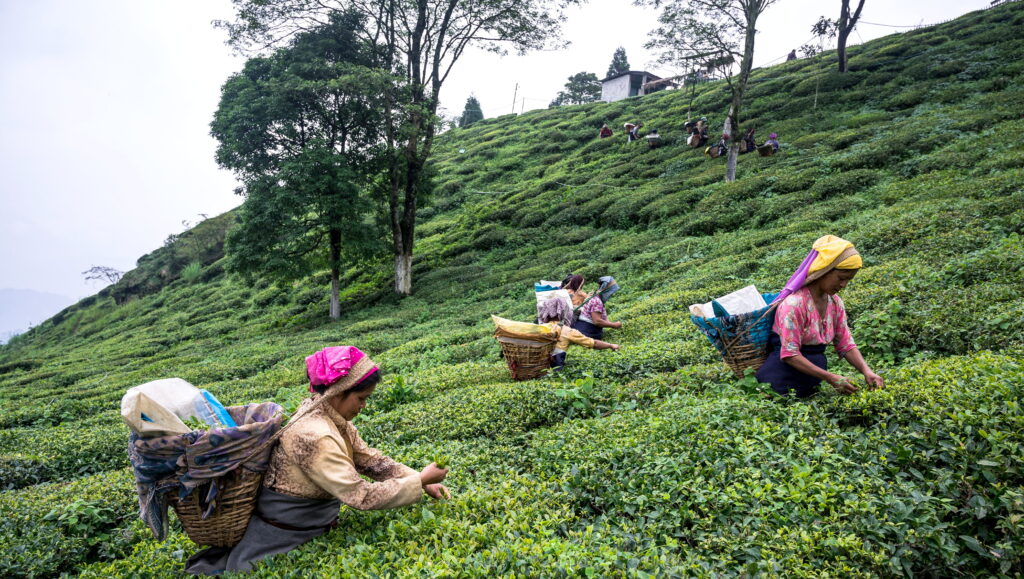
World-famous Darjeeling tea
The Darjeeling tea is a big draw for tourists to this bustling hill station in West Bengal. It was the British that originally realised its potential for growing tea. The tea industry in Darjeeling continues to prosper as it produces an assortment of exquisite tea varieties such as Hybrid Assam, China Jat and China Hybrid, with the region’s sporadic rainfall and high altitude making it ideal for growing tea.
Although the annual tea yield is comparatively lower than Assam, but the variety of black tea it produces is believed to be the finest in the world. It is also among the most expensive tea varieties in the world. Darjeeling teas have received a variety of grades like Broken Orange Pekoe and Flowery Orange Pekoe granted for the quality and even the length of the tea leaf as it goes through processing where it is dried, crushed and fermented.
You can plan a stay at a tea estate like the Glenburn Tea Estate and live the plantation life in its colonial bungalow, walk around the estate, see the tea fields, watch tea pickers go about their work, enjoy a hot cup of tea and scones in the afternoons and grand meals always accompanied by a strong cup of Darjeeling tea.

Himalayan Mountaineering Institute
Inside the Darjeeling zoo is the renowned and esteemed Himalayan Mountaineering Institute or HMI. Founded in 1954, it has been responsible for training some of the leading mountaineers of the country. You can browse the brilliant Mountaineering Museum that has memorabilia from the Everest expeditions that began from Darjeeling, taken between 1922 and 1924.
There are exhibits from more recent trip attempts as well as a successful climb in 1953. Outside the museum is Tenzing Norgay’s samadhi and his statue. The brave mountaineer who had conquered Everest served as the director and advisor at the HMI for several years. Look up one of its most fascinating displays, a telescope presented by Hitler to the Nepali Army head.
If you are an enthusiast, you can even sign up for a 28-day beginner’s programme as well as advanced mountaineering courses the institute runs between March and May and then from September to December.

Japanese Peace Pagoda
Squatting on a hillside that is about 2 kilometre south of the Darjeeling town centre is the sparkling white Peace Pagoda which at 91 foot soars into the sky. The structure is remarkable for its historical importance, for being one of the more than 70 pagodas built by the Japanese Buddhist Nipponzan Myohoji organisation around the world.
The neighbouring temple holds a drumming puja in which visitors are asked to join in in the rituals by offering them a hand- drum each. To get to the pagoda you need to walk on the Gandhi Road and the AJC Bose Road and go past the Astroparticle Physics and Space Science centre.
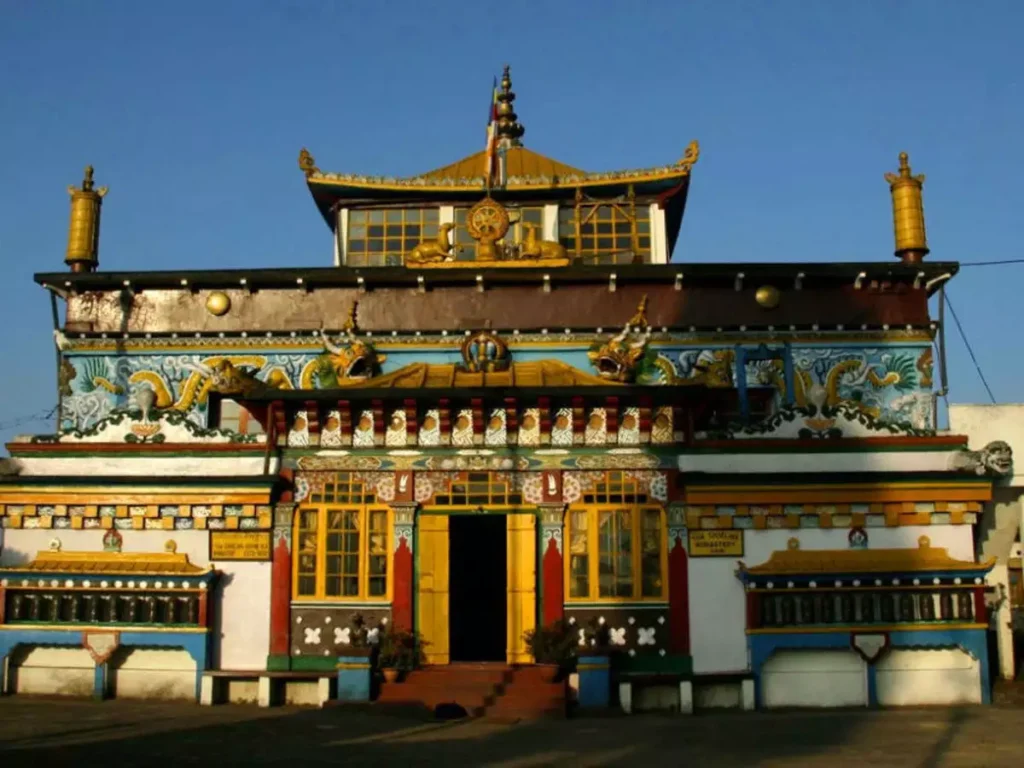
Yiga Choeling Gompa
Founded in 1850, this is easily Darjeeling’s most popular monastery that is home to about 40 monks of the Gelugpa school. The temple is an abode of peace and houses some beautiful murals. In the sanctum is a 16-foot-tall Jampa statue, also called Maitreya or the future Buddha and has around 300 exquisitely-bound Tibetan scriptures.
The Gompa lies about 6 kilometre south of Darjeeling, on the western corner of Ghum. You can de-board at the Ghum station and walk about 100 metre west on the main road towards Darjeeling and then turn to your left and you will find a signage for the monastery that would be about 600 metre further up.

Himalayan Tibet Museum
The museum is basically one large colourful room that is a perfect introduction to the Tibetan culture. There are fascinating exhibits introducing the tourists to the Dalai Lama, the monasteries, Tibetan religion, scriptures, history, Tibetan medication and the geography of Tibet.
Among the displays you will come across beautiful thangkas or Tibetan paintings on cloth, a map of Tibet in 3D and a sand mandala which is a meditation aid that symbolises the universe.

Tiger Hill
It is once-in-a-lifetime experience to watch the dawn break over the breathtaking 250 kilometre expanse of the Himalayas that includes Mount Everest at 29,028 foot and Khangchendzonga at 28,208 foot and two others of the five highest peaks in the world. You need to wake up very early to catch this spectacle and take a jeep ride to the Tiger Hill at 8497 foot, lying 11 kilometre south of Darjeeling, over Ghum.
You can get the best views in autumn and spring months, a time the place is crawling with tourists. There are about a hundred jeeps leaving for Tiger Hill every day at 04:00 am, making traffic jams quite common en route. You can book a sunrise trip with stops at the Batasia Loop and a monastery in Ghum on your way back.

Happy Valley Tea Estate
Set up in 1854, the Happy Valley Tea Estate on the northwestern edge of the town is a place to garner some insights on tea plantations, the process of producing tea from plucking to drying and processing that happens every year between March and November. A staff at the tea estate would take you through the tea factory alive with a array of aromas and introduces you to the entire process of tea production, from withering, rolling, fermenting and ultimately drying.
You can also taste a variety of teas and find out how white, black and green teas essentially come from the same tea leaf. You can ride the free shuttle van that plies from Bhanu Bhawan in the town centre from 09:30 am. Its just half a kilometre down a zigzag path to the tea estate, from a signed turn-off on Lebong Cart Road, almost a kilometre northwest of the Darjeeling town centre.

Padmaja Naidu Himalayan Zoological Park
One of India’s finest zoos set up in 1958, the Padmaja Naidu Himalayan Zoological Park works towards the conservation of Himalayan fauna and makes efforts to preserve it. The park is nestled in a rocky, forested territory and is home to the clouded leopard, Himalayan wolf, Asiatic black bear and red panda to name a few.
The snow-leopard breeding centre that is otherwise closed to public, and together with the zoo are home to the largest population of captive snow leopards in the world. You can take this pleasant walk towards the northwest from Chowrasta, going about 2 kilometre downhill.

Bhutia Busty Gompa
The gompa was previously located on Observatory Hill and was re-constructed in its present location in the 19 th century. The temple is home to some exquisite murals that depict the life of Buddha, with the Khangchenzonga affording a spectacular backdrop. The prayer takes place at 03:00 pm, the only time the temple opens its doors to the public.
The monastery is less than a 2 kilometre walk from Chowrasta, beginning from CR Das Road and then going to the right around 200 metres passing the Central Nirvana Resort. You can ask for directions to further get to the gompa.
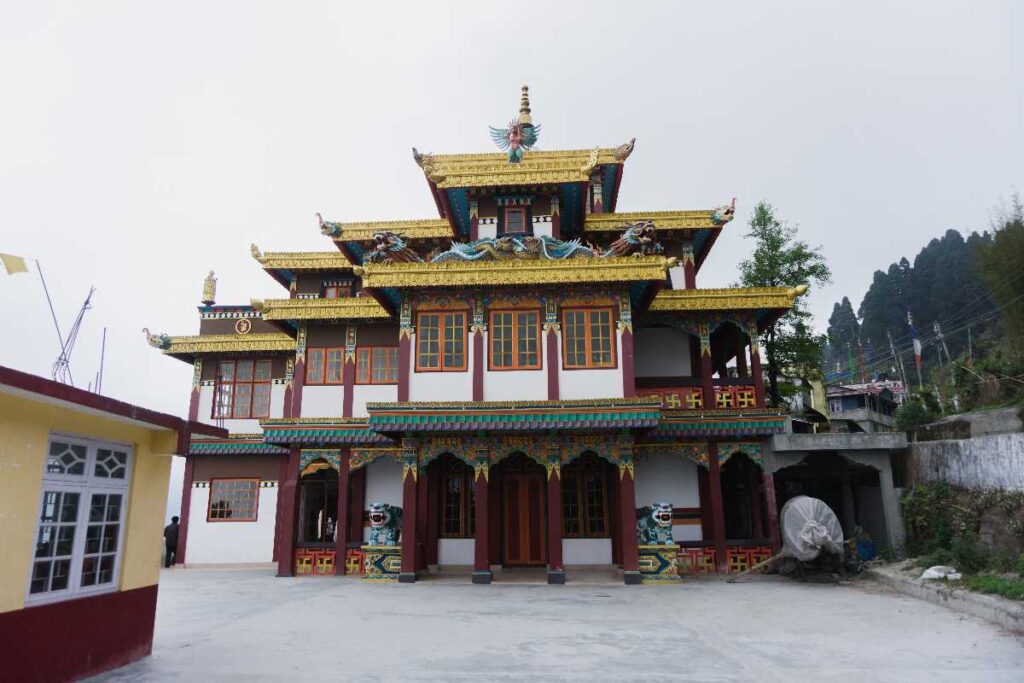
Mak Dhog Gompa
The century-old Nyingma school monastery is run by the folks from Nepal’s Yolmo in Langtang who had migrated to Darjeeling some 150 years ago. On the upper floor is the shrine dedicated to Rinpoche or Padmasambhava and also the founder of the monastery Sangay Lama. The entire upper floor has a serene ambience and is a great place to drop by for some peace and quiet.
The gompa lies halfway from Tenzing Norgay Road that is located between Darjeeling and Jorebungalow. The 40-minute walk is quite a pleasant one.

Ghum Museum
The museum is located inside the Ghum Railway Station which is quite antiquated itself. This quaint museum houses memorabilia and photographs from the days of Raj during the making of the Darjeeling Himalayan Railway. On the outer courtyard is its most splendid display, Baby Sivok, the oldest engine used by the Darjeeling Himalayan Railway.
There are toy train rides with a stop at the Ghum Railway Station for about half an hour, allowing you to browse the museum at a relaxed pace. The museum admission ticket is included in the toy train ride.

Druk Sangak Choeling Gompa
This is about half way on the road between Ghum and Darjeeling. A massive monastery that was inaugurated in 1993 by the Dalai Lama, Druk Sangak Choeling Gompa is visited for its breathtaking frescoes and for the fact that it is home to around 300 Himalayan monks who reside here and study literature, philosophy, meditation, music, astronomy and dance.
You can be a part of the prayer that happens everyday between 05:00 pm and 06:30 pm.
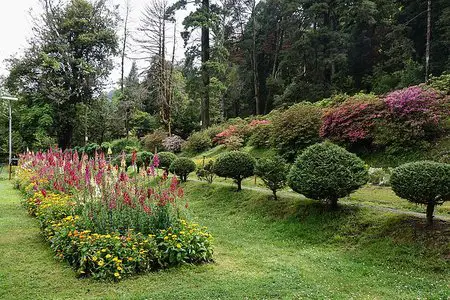
Lloyd Botanic Garden
Take a break from the razzmatazz of Darjeeling and visit this green patch in the heart of the hill station. Lloyd Botanic Garden is known for its array of Himalayan flora, most importantly rhododendrons and orchids for which the region is famous. You need to follow the signage from Loch Nagar close to the Motor Stand and suddenly you will be able to hear the cicadas and the honk of the jeeps would be a distant memory.
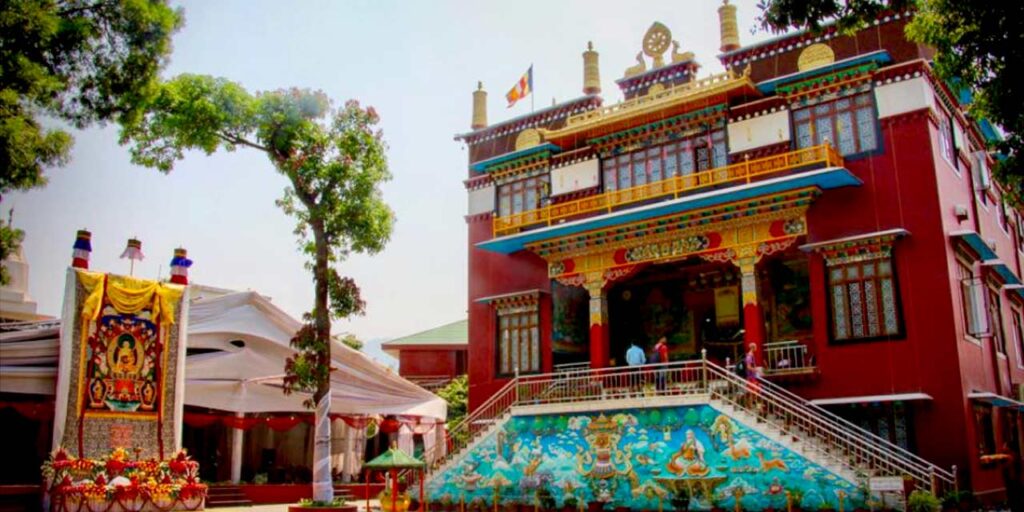
Guru Sakya Gompa
This Sakya-school monastery appears like a fortress from a distance. It was established in 1909. But the new temple which is colossal that has come up over there was built in 2015. The monastery conducts prayer sessions between 05:30 am and 07:30 am, a perfect time to catch a prayer for those returning from a sunrise trip to Tiger Hill.

Samten Choeling Gompa
Samten Choeling Gompa is a Tibetan-style monastery that has the largest Buddha statue in all of West Bengal. It also houses the ashes of Anagarika Govinda, a German Buddhist mystic and writer. Unwind with a bowl of thukpa at the little cafe in the venue.

Dhirdham Mandir
Resembling Nepal’s Pashupatinath Temple in Kathmandu, the Dhirdham Mandir is notable for being the very few Hindu temples found in the region. It is located just below the Darjeeling Railway Station and affords a splendid view over the hill station from the temple complex.
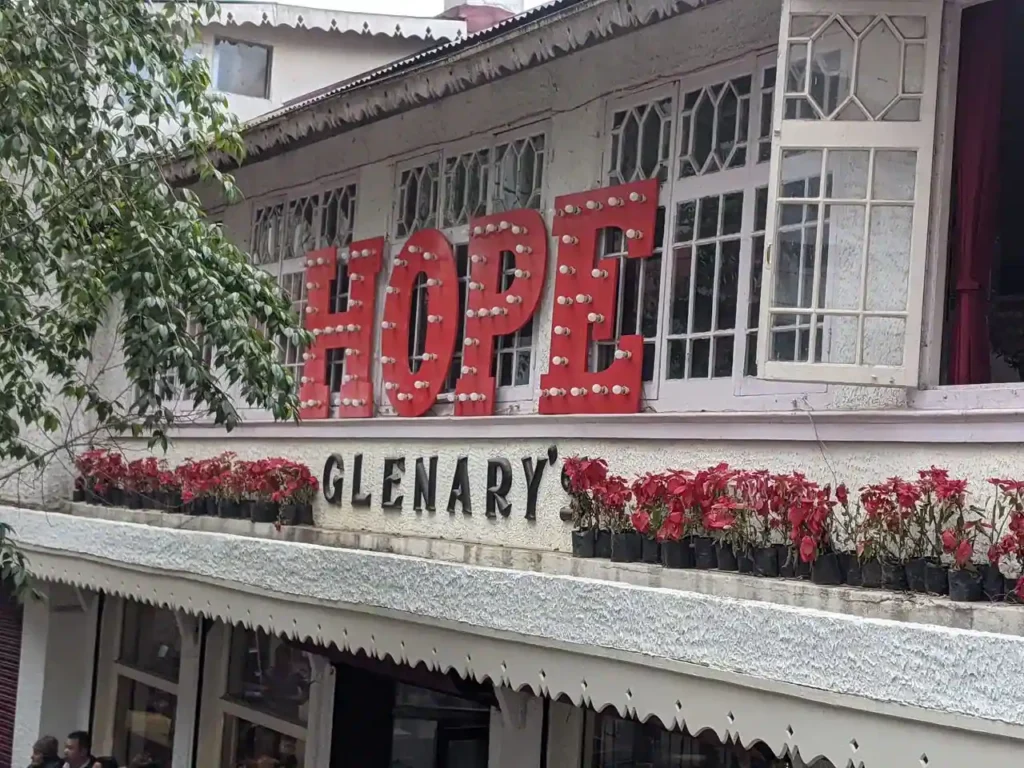
Eating-out in Darjeeling
Don’t forget to stop at Kunga Restaurant on the Gandhi Road in Darjeeling. The cosy little wood-paneled place that is owned and run by a Tibetan family is known for its lush thukpas, succulent Tibetan momos and also the Shabhaley, a form of Tibetan pie. The muesli and fruit with yoghurt is quite popular here.
The restaurant stays busy through the day and is preferred by the locals too for the authenticity of the cuisine. Another place serving authentic Tibetan cuisine in Darjeeling is Dekeva’s. It has the Chinese staples as well as authentic Tibetan grub like tingmos, the Tibetan steamed bread as well as a range of Tibetan noodles, thukpas and momo.

Shopping in Darjeeling
Head to Nathmulls Tea Room on Laden La Road for some tea shopping in Darjeeling. Some of the finest and most authentic Darjeeling tea is available here as they are one of the best retailers of tea in the hill station.
You can expect to find over 50 locally-grown tea varieties here. The teas are priced between INR 200 to INR 400 per 100 grams for a good black tea, whereas if it the finest flushes you are after, expect to dole out up to INR 2500. The shop is not without its pretty tea merchandise such as quaint teapots with Tibetan designs, tea cosies, tea strainers which work as thoughtful souvenirs.
Head to Sunset Lounge to try out some of Nathmulls teas. For some souvenir shopping, visit Hayden Hall, a place to buy authentic Darjeeling handicraft. You can buy the authentic Tibetan-style yak wool rugs created by women from the downtrodden areas of Darjeeling. You can watch them work on the carpets at the back of the shop.
Aside from the rugs you can find pretty tea cosies, handbags and other pieces of handicraft that can adorn your walls and shelves back home.